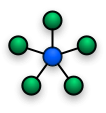Cell and tissue lysis hub: Difference between revisions
From OpenWetWare
Jump to navigationJump to search
(illustration: hub icon to highlight the page type) |
(comparison of lysis method section) |
||
| Line 8: | Line 8: | ||
* [[Jacobs:Protocol Total Protein Isolation Using RIPA Lysis Buffer]] - Jacobs Lab: cell line lysis for protein (method: RIPA buffer) | * [[Jacobs:Protocol Total Protein Isolation Using RIPA Lysis Buffer]] - Jacobs Lab: cell line lysis for protein (method: RIPA buffer) | ||
* [[Streptomyces:Protocols/Mini-Maxi Prep]] - Streptomyces community, East Anglia: bacteria lysis for DNA (method: NaOH) | * [[Streptomyces:Protocols/Mini-Maxi Prep]] - Streptomyces community, East Anglia: bacteria lysis for DNA (method: NaOH) | ||
== Comparison of lysis methods == | |||
=== Sonication === | |||
* most efficient method of cell fractionation | |||
* problem: heat build up which can denature proteins (proportionate to length of sonication) | |||
* precaution: do on ice and sonicate intermittantly | |||
=== Homogenisation === | |||
* best for animal tissue; less suitable for cells | |||
* precaution: do on ice to reduce heat build-up and denaturation | |||
=== Freeze-thaw === | |||
* least effective method | |||
* plus: does not denature proteins as much as other methods | |||
=== Detergents === | |||
* chemical method of lysis | |||
* problems: detergent may inhibit subsequent reactions | |||
* problems: detergent may disrupts protein interactions | |||
Revision as of 03:16, 26 June 2008

This page should point you to the many different general and lab-specific protocols describing tissue and cell lysis and serve as forum for comparison.
- Silver: Lysate for Western - Silver Lab: cell lysis for Western (method: Triton)
- Sauer:Lysing E. coli with Lysozymes - Sauer Lab: bacteria lysis (method: lysozyme)
- Blackburn:Yeast Colony PCR - Blackburn Lab: yeast lysis for colony PCR (method NaOH)
- Jacobs:Protocol Total Protein Isolation Using RIPA Lysis Buffer - Jacobs Lab: cell line lysis for protein (method: RIPA buffer)
- Streptomyces:Protocols/Mini-Maxi Prep - Streptomyces community, East Anglia: bacteria lysis for DNA (method: NaOH)
Comparison of lysis methods
Sonication
- most efficient method of cell fractionation
- problem: heat build up which can denature proteins (proportionate to length of sonication)
- precaution: do on ice and sonicate intermittantly
Homogenisation
- best for animal tissue; less suitable for cells
- precaution: do on ice to reduce heat build-up and denaturation
Freeze-thaw
- least effective method
- plus: does not denature proteins as much as other methods
Detergents
- chemical method of lysis
- problems: detergent may inhibit subsequent reactions
- problems: detergent may disrupts protein interactions